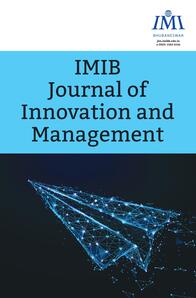
1 Indian Institute of Management Visakhapatnam, Andhra Pradesh, India
2 Department of Business Administration, Sambalpur University, Sambalpur, Odisha, India
3 Hindalco Industries Ltd. Hirakud, Odisha
Creative Commons Non Commercial CC BY-NC: This article is distributed under the terms of the Creative Commons Attribution-NonCommercial 4.0 License (http://www.creativecommons.org/licenses/by-nc/4.0/) which permits non-Commercial use, reproduction and distribution of the work without further permission provided the original work is attributed.
Drawing on the social innovation process adapted by Van de Ven et al. (2008), we studied the different phases of social innovations in terms of ideation, development and scaling that waved during the pandemic of COVID-19. We also measured the effectiveness of the innovations on different parameters in fighting the Coronavirus when it was at its peak in the first wave. In this article, we also postulated how the various innovations impacted social life. A total of 24 innovations were explored and studied using the qualitative content analysis method. Data were analyzed using the Maxqda software (version Pro 2020). Results revealed that most of the innovations were implemented with new and latest technologies and they had developed using optimum resources. Further, it was noticed that most of the innovations had achieved the scaling and implementation phase in managing the COVID crisis.
COVID-19, global pandemic, social innovations, societal benefits, innovation phases
Introduction
COVID-19 entered India in December 2019. According to an official data, about 215 countries were affected by this deadly disease. In the first wave of the pandemic, a million people got infected and the cases were still growing until the second and third waves. Due to this effect, social life was thoroughly disturbed and distorted. However, at the same time, various social innovations took place to fight this disease. The pandemic started in March 2020, and in response, research institutions, organizations, social entrepreneurs and government in the early efforts made various strategies to reduce the transmission rate of the virus. They introduced many innovative products to control the disease and resolve health issues in society. The intervention of the Indian government in terms of social innovation in preventing the disease was immense. Under the dynamic leadership of Hon’ble Prime Minister Shri. Modi Ji, dealing with the social and economic crisis issues was controlled. Though the pandemic coined a situation constraining in India, it also created a space for social innovation during COVID-19.
Many new ideas and thoughts were developed to reduce the transmission rates and control the impact of the virus. This paved the way for social innovations’ development and contribution, leading to societal benefits. Social innovations are proved to be an effective and efficient tool in managing crises. They are gaining momentum and acknowledgement due to their increased role in sustainability, social issues and addressing global pandemics. In this study, we brought out the part of social innovations in managing the pandemic. The research objective of this study is to investigate the effectiveness of the innovations on different parameters in fighting the Coronavirus.
Following the above introduction, the article is organized as follows: first, the theoretical background of the social innovations is discussed, which provides a crystal picture for understanding the innovations that happened in India. Further, the literature on social innovation is studied to focus on how it has increased its importance in dealing with global pandemics like COVID-19. Next, the research context of the selected social innovations is stated. The analysis part focuses on the measurement of the effectiveness of social innovations. The article highlights the research findings and discusses practical implications for social practitioners, entrepreneurs, innovators and researchers.
Literature Review
Social Innovation—A Theoretical Background
Social innovation refers to new ideas and thoughts that meet social problems. In other words, social innovation may be defined as innovative activities motivated by accomplishing societal goals and objectives. In this sense, it is understood that social innovation paves the way for development and growth, leading to societal benefits. On an allied note, innovation is not only about the discovery of leading-edge technologies but also about solving social issues and challenges (Priestley, 2020). To Roome (2013), social innovation is that supremacy which can change the economy and society of any country. Social innovations are essential to bringing social changes and developing mechanisms to address social problems (Butkeviciene, 2009). Meanwhile, the Social Innovation Review editors believe social innovation is a unique solution to social issues that are effective, efficient, sustainable and value-based primarily to society rather than private individuals (Phills et al., 2009, p. 36).
As outlined by the World Economic Forum (2016), social innovation is:
The application of innovative, practical, sustainable, market-based approaches to benefit society in general and low income or underserved populations in particular.
Social innovation follows a process model. Past studies have indeed shown that there are many process models to illustrate innovation development. There are many views regarding the process. In a related vein, Van de Ven et al. (2008) propose three essential phases in social innovation: idea generation, development and implementation (scaling). The first phase discusses about developing new ideas or thoughts for solving social issues. The second phase focuses on idea testing and the feasibility of exploring the thoughts. In the third phase, the developed ideas are scaled and implemented for the benefit of society. Figure 1 portrays the social innovation phases. This article builds on the literature on the social innovation process to show the effect of various innovations in managing the crisis of COVID-19 in India. The disease affected every aspect of life
around the globe, from individual to institutional operations. Governments worldwide were struggling to fight the disease. In this setting, the role of social innovation was essential to help overcome this crisis. Many innovative ideas and thoughts were translated into innovations to fight the current situation.
Figure 1. Phases of Social Innovation.
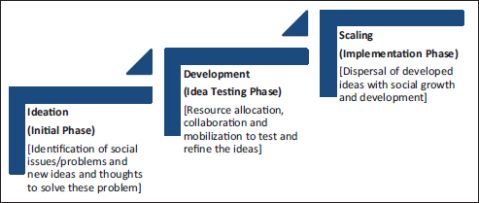
Source: Adopted from Van de Ven et al. (2008).
Social Innovation and COVID-19: Global Context
In an interview, an entrepreneur and author of ‘Today’s Innovator’ Proietti (2020) alleged that they do not have to wait for someone to help them move on. They should take their cross and move towards the goal of how complex their future is. They also advocate that this COVID-19 pandemic creates an ‘Isolation Economy’ where they can embrace the disruption and innovation that provide a solution for a better life in the world. However, it involves high risk. It is also advocated that they must focus on how to proceed safely within their regular production model. HIV/AIDS had been a pandemic in Africa. The need for promoting scientific innovation and how the social and cultural aspects influence the pandemic situation of HIV/AIDS in Kenya and Zimbabwe (Susan & Mugwagwa, 2009).
Similarly, Gene Quinn (2020) emphasizes that ‘the U.S. innovation policy should be proactive to tackle the next pandemic.’ It was also discussed in the article ‘Lesson from COVID-19’ those medical diagnostics are not patentable in the US, which leads to de-emphasizing medical diagnostics and owing to this, investors are uninterested in investing in their research and development activities. Moreover, fundraising, the lifeblood of research and development, is also closing. And all those activities cause to lack testing and innovation. Stressing the innovation aspects, Park (2020), in the article ‘Preventing the next pandemic,’ focuses on how public health can be a pivotal point in using new technology to be one step ahead of a future outbreak. The article also enlightened some of the technological advancements used for catching cases in the early hours to minimize the effect of the pandemic so that the health system would be less exaggerated. Advanced innovations like Artificial Intelligence, Telehealth App like MaNaDr (Singapore), Google Project, Remote monitoring, Chatbots and Call centres are helping to trace contact details, monitor patients across distances and counsel patients from home. Due to the COVID-19 pandemic, internet use became more crucial as we all live in the virtual world. According to Cerf (2020), this pandemic has taught us how virtually we can come into existence. The internet, web, videoconferencing, collaboration tools, email and social media are now primary avenues for business, social interaction and entertainment. We are all devoting our time and money to it. Our work life has also changed with the use of technology and innovations. The article also highlighted that it becomes our responsibility to play a prominent role in shaping our post-COVID-19 society. When there is a necessity, there is an invention. But this invention must give benefits to the community. West Michigan has proved this thing. Andel (2020) enlightens that in this COVID crisis, West Michigan showed its vivid side to the world with its generosity and adaptability to scientific innovation. Moreover, its manufacturing sectors stepped up to produce protective masks and gloves for health care workers, as well as critical parts for ventilators.
Similarly, Handforth (2020) has discussed some of its organization’s initiatives taken during this COVID-19 pandemic. Likewise, UNDP (United Nations Development Programme) and Hacker, the most significant online open-source hardware community, partnered with the world’s biggest names in technology and launched the COVID-19 Detect and Protect challenge. The terms are Amazon Web Services, Arduino, Arm, Avnet, Edge Impulse, Google, Microsoft, NVIDIA, NVP, Nordic Semiconductor, Soracom and The Things Industries. Its main aim is to create a global platform of open-source solutions that can detect COVID-19 cases, prevent disease spread and protect individuals and society.
Moreover, the UNDP was also calling on all hardware and software developers, product designers, scientists, hackers, makers, innovators and inventors to come together and help those who could be most affected by these pandemics. The UNDP not only focuses on providing a platform for open-source solutions but also aims to identify and mobilize promising ideas wherever they may be found. Most importantly, they universally spread a message of ‘Together We Can.’
Express Computer (2020) surveyed different countries with combat policies and tried to defeat them with innovative technologies. Some countries have done a better job than Italy and Spain, South Korea and Singapore. In the same way, India, Australia, China and other countries are doing their best to sustain this pandemic. They have invented various digital apps that help trace contacts, detect positive patients and provide precious information about prevention. Other than this, these countries also engaged in the production of PPE-Kit, Sanitizer and Sanitizer Tunnels, etc., for the COVID-Warriors as well as for the public. World Health Organization (WHO) Africa (2020) showcased those African innovators are leading the COVID-19 crisis through home-grown creative solutions to address critical gaps in response to COVID-19 in collaboration with WHO. Various innovations have been developed. These are ballparked from interactive public transport, contact tracing apps and dynamics data analysis systems to rapid diagnostic testing kits, mobile testing booths and soft coat critical care beds. Moreover, eight innovators from Ghana, South Africa, Guinea and Kenya presented their solutions already being implemented in their respective countries. WHO believes that providing ongoing support and a regular platform to African innovators may bring more prosperous to this pandemic.
After the outbreak of COVID-19 in China, it captured more than six countries within a month and in a few months, the pandemic reached over 100 countries with no sign of a vaccine. This pandemic affected both the health care sector and the economy. Farrugia et al. (2020) claimed that the COVID-19 crisis taught the world a lesson about innovation and coordination. They advocated that this pandemic taught them ‘how to be together’ as the public, private and government collaborated to fight against this pandemic. The private industries, academic institutions and start-ups such as Mayo Clinic, the University of California Health Care system, Amazon Web Series and Microsoft come together, which is called cross-sector partnership, to fight against it. This cross-sector partnership brings many benefits such as a telehealth program, fast-tracking applications process, and so on. In the US, collaboration among health care institutions and industries facilitate speedy access to experimental treatments. It shows we are not only experiencing cross-sector partnerships but innovation and the use of new technology as well. Collaboration with investors across the county initiates a national effort to produce convalescent plasma from eligible donors who have recuperated from COVID-19. Also, the US-based clinician Mayo Clinic has developed a serology test that would be the following critical tool for health care providers.
Moreover, the Mayo Clinic has expanded virtual services to patients. Besides, collaboration brings opportunities to apply artificial intelligence and machine learning to new medical problems. Therefore, while the COVID-19 pandemic created a negative wave, it also opened up the possibilities for innovations in the world.
Social Innovation and COVID-19: Implications from India
Today, it is hard to imagine that the year 2020 would always be remembered as a disaster due to the deadly virus that spread to almost all parts of the world. The WHO named this virus a novel and declared as a big pandemic in history. Looking back at the account, we could find various pandemics and epidemics badly influenced millions of populations and severely impacted social life. A crisis such as HIV/AIDS, MERS, Ebola, SARS, and so on, to name a few. The gravity of the crisis caused by COVID-19 is compared to other global diseases. As per the WHO report, this virus has impacted several countries such as America, Brazil, India, Korea, Malaysia, Singapore, Japan, China, and so on. This disease has posed significant challenges to the worldwide economy and people’s daily lives. In India, the disease has been worsened to 17 lakhs.
In the immediate response to the COVID-19, India tried to make the fight against COVID-19 a people’s movement. According to an official Ministry of Health and Family Welfare (MoHFW) report, the Government of India provided medical assistance to more than 150 countries worldwide. The government announced an economic package of over `20 lakh crore to help the country fight this pandemic. The vision of Atma Nirbhar Bharat was established among the countrymen. Upon the announcement of the lockdown in the entire country, the government announced a food security package for 813 million citizens in India which benefitted about 700 million people. Prime Minister Modi Ji urged Do Gaj Doori to follow to maintain social distance and stressed using the Aarogya Setu App. Furthermore, the government focused more on the health care sector and provided the license to 165 distilleries and 963 independent manufacturers to produce hand sanitizers for mass.
India started producing PPEs and N-95 masks in large numbers to address the challenges. During this time, a public charitable trust, ‘PM Cares Fund,’ emerged to collect funds from the public to deal with a kind of emergency or distress situation. After a period of panic, India was allowed to export HCQ medicines to USA and Brazil. This medicine was provided to other countries, such as Afghanistan, Israel and Africa. Due to the COVID-19 pandemic, the government stressed more virtual work, wearing masks and gloves, working from home, etc. This situation also created many issues such as problems of migrant labors, distribution of food to the needy, dealing with essential commodities, management of infections, resource mobilizations and human resources mobilizations. Looking into the long-term issues, COVID-19 cropped up challenges such as reinstating the Indian economy, digital empowerment in India, improving the health care sector, medical infrastructure, and so on. India, being a densely populated country, faced severe effects of COVID-19. Many organizations, individuals and society have come forward to deal with the post-pandemic challenges. The crisis became a strong driver of innovation, research and creativity.
Further, abundant creativity and innovation emerged at the national, institutional, organizational and individual levels to fight this pandemic. Many of the inventions and social innovations stressed the need for time and effort to solve the societal issues and problems posed by the pandemic. In India, several social innovations emerged in the fight against COVID-19 (MoHFW Report, 2020).
Various organizations in India, such as Central Government, State Government, DRDO, IITs, IIMs, NITs, Central Universities, Indian Navy, Indian Army, Police Administrations, Municipal Corporations, and so on, came forward to fight this crisis through innovations and creativities. The virus affected the environment, food system, urban politics, social norms, body and soul, etc. This virus forced socially innovative initiatives, expanding resources and thinking of new ways and instruments to survive this situation. In its efforts to limit the virus, India emerged with various social innovations such as Asimov robotics, Aarogya Setu, Nocca robotics, Qkoy, Marut drone tech, digital stethoscope, Automatic mask machine, Jeevan setu ventilator, covisafe, and so on, to name some few (MoHFW Report, 2020). Appendix I describes the social innovations in India during the COVID-19 period. These innovations are helping to overcome this pandemic even now also. Thus, this article focuses on social innovations in the crisis as a way of measures to solve the societal issues in India. Therefore, this article explores the phases of social innovation in India and their effectiveness in achieving control over the crisis. The research questions for this study are as under:
RQ1: What are the various phases of the social innovations that waved during the COVID-19 period in India?
Figure 2. Conceptual Framework of the Study.

Source: Researcher’s framework.
RQ2: How social innovations in India are helping in managing the crisis of COVID-19?
Based on the above RQ1 and RQ2, we proposed the conceptual model for our study, as depicted in Figure 2.
Methodological Context
Research Design and Approach for the Study
This study considered the exploratory nature of the research work and the importance of ensuring an in-depth analysis of the phenomenon from different perspectives. Thus, we adopted the case study analysis approach to seek more meaningful interpretations of the qualitative results. The research was conducted using qualitative content analysis. The Indian social innovations cases were analyzed during the COVID-19 period to achieve these goals.
Sample Choice and Data Collection
The twenty-four case studies of innovations were analyzed to study the phases and effectiveness of social innovations. We considered those social innovation cases that directly impacted the management of the COVID-19 crisis. To meet the requirement of the research study, we used criteria and convenient sampling. We deduced the study’s contents from various newspapers, websites, public reports, etc. We traced the relevant content from public sources based on our requirements. We identified five important domains for gathering the case information. They were the foundation of the innovation, objectives, development, technology used and effectiveness in managing crises.
To collect the data, we searched the case information published by various national newspapers, websites of government organizations about COVID-19, documents on COVID which were publicly available, etc. The data were collected during the first wave of COVID from March 2020–December 2020, as most of the innovations and improvements in dealing with the crisis evolved during this time.
Measures
Nine critical factors were selected to assess the relevance and effectiveness of social innovations in various spheres. To do this, an in-depth literature review was done considering the available definitions and propositions. Initially, 24 factors were identified and finally, nine factors were retained by considering the views of a group of competent experts opinions from management and the organization. Table 1 depicts the nine factors and their measurement extents. The phases of the social innovations were analyzed using the Social Innovation Process model borrowed from Van de Ven et al. (2008), as summarized in Figure 1.
Table 1. Measurement Parameters of the Social Innovations in India During COVID-19.
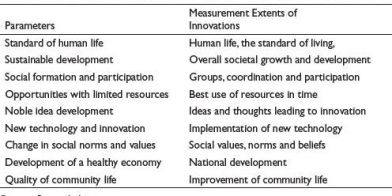
Source: Research data.
Figure 3. Coding of Measurement Parameters in Maxquda.
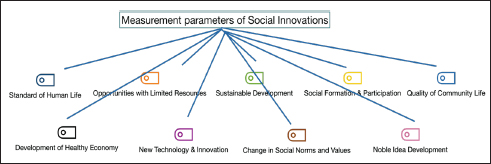
Note: For reference to color in this figure, please refer to the web version of the article.
Data Analysis Using the Maxqda Software
Maxqda is a software designed and developed for analyzing qualitative data and quantitative data. This is a very innovative analysis software embedded with graphics and objects. We used this software for data analysis.
We followed the nine measurement parameters and the social innovation process model depicted in Figure 1 to analyze the innovation phases (ideation, development and implementation) and their effectiveness in fighting COVID-19. The content analysis was done with Maxqda Analytics Pro 2020. In all 24 cases, information collected from various published sources was imported into the software for analysis. There were different steps followed to treat the data in the software. They were:
Coding of Measures for Content Analysis
Code was assigned to all nine measurement parameters to analyze the social innovations in the software. Further, the cases were investigated and codified for content analysis. Table 2 shows the overview of codes and codification of all the cases. As depicted in the table, a total of nine codes were used for the segmentation of the cases.
Categorized Survey Data Analysis to Ascertain the Description of Social Innovations
The data about the social innovation cases were collected using an internet search (Please see Figure 4). Further, the surveyed data were explored and imported into the software. To get a comprehensive picture, each case is analyzed individually and then the respective measurement codes were systematized and described for the cases. This analysis categorized each social innovation case into different measurement parameters based on the in-depth study and content analysis. Appendix I shows the detailed categorized analysis of each case for comprehensive understanding.
Table 2. Coding Features of the Measurement Parameters.
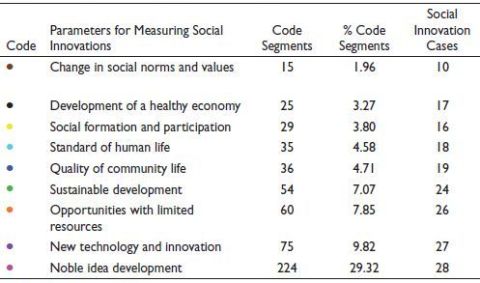
Source: Researcher’s results.
Note: For reference to color in this figure, please refer to the web version of the article.
Figure 4. The Various Internet Sources from Where Data About the Social Innovation Cases were Collected During the First Wave of COVID.
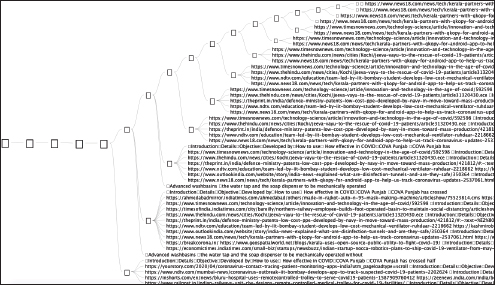
Source: Resesarcher’s results.
Table 3. Descriptive Statistics of the Content Analysis for the Social Innovations During COVID-19.
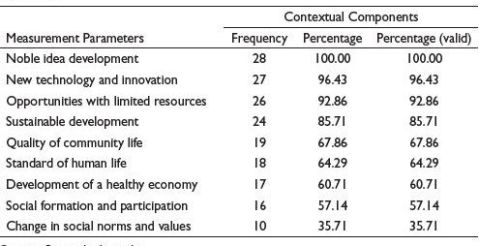
Source: Researcher’s results.
Code Frequency Analysis to Measure the Impact of Social Innovations
The code frequency analysis was done to ascertain how often the measurement parameters were assigned to each social innovation case. The reflection of the frequency distribution of all the cases is shown in Table 3. This analysis helps indicate the effectiveness of the social innovations in terms of occurrence on the number of times the measurement code is assigned during content analysis.
Table 4. Grid Relationship Between Social Innovations and Measurement Parameters.

Source: Researcher’s results.
Figure 5. Analyzed Relations of Codes and Codes Occurrence (measurement parameters) in the Documents (social innovations).

Note: For reference to color in this figure, please refer to the web version of the article.
The above table shows that the maximum frequency is assigned to the factor ‘noble idea development,’ whereas the minimum is to ‘change social norms and values’. Notably, most social innovation cases were of new thoughts and ideas.
Code Mapping Analysis to Identify the Collinearity of the Measurement Parameters
The code mapping was done to define connections and relationships between various measurement parameters and with the social innovations (Please see Figure 5). The map presents the interconnection between different coded measures, representing the additional facts and phenomena in our research work. As we can see, the measure ‘noble idea development’ has been coded frequently for the various social innovations (the code circle is larger). Similarly, we can note that ‘new technology and innovation’ and ‘opportunities with limited resources’ have also been used more frequently on the map. Further, the map shows that the factors ‘sustainable development’ and ‘standard of human life’ have more collinearity in the social innovation effectiveness (the two factors are placed closer on the map). It is interesting to note that all the parameters are highly connected in measuring the performance of social innovations.
Grid Analysis to Study Relationships
The grid analysis is done to study a particular phenomenon and the relationship between social innovations and the various measurement parameters. During the investigation, the details of the social innovations were displayed in the column and the parameters were in the rows (please see Table 4). The grid table indicates various relationships and levels of effectiveness of the innovations. As we can note, a total of 509 codifications were done for all innovations. The highest segment is ‘noble idea and development.’ Further, new technology, innovation and opportunities with limited resources were noted as the other highest impact on the innovations. In terms of effectiveness, ‘coronavirus disinfectant tunnel,’ ‘contactless sanitizer dispenser,’ and ‘Marut drone tech’ have the highest impact on fighting the crisis.
Table 5. Analysis of the Innovation Phases During COVID-19.
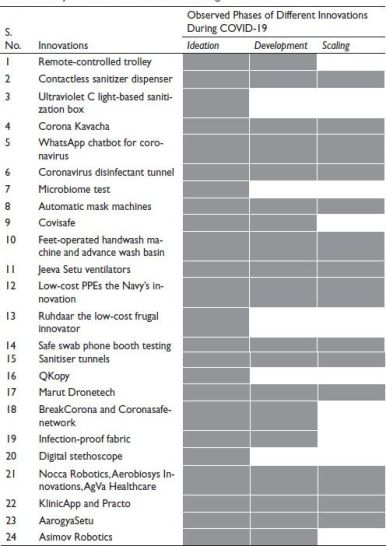
Phase Analysis of the Social Innovations
Table 5 shows the phase analysis of the innovations during COVID-19 (the shade in the table indicates the extension of phases). The contents were studied based on the data collected to identify the various stages of the innovations. The social innovation process adapted from Van de Ven et al. (2008) is being used as a framework to study the phases of social innovation.
Discussion
From Table 2, it is observed that a total of nine factors (parameters) have been coded to measure the effectiveness of social innovations. Around 29.32% of the innovations are coded as ‘noble idea and development.’ Whereas new technology and innovation are recorded at 9.82%, opportunities with limited resources to be as 7.85% and sustainable development at 7.07%. Thus, it is pertinent to note that most innovations during the first wave of COVID-19 were inclined toward new thoughts, ideas and developments. Table 3 in the data analysis shows the frequencies of the parameters. In the table, it is observed that noble ideas and development, new technology and innovations, opportunities with limited resources and sustainable development have been given more weightage regarding the effectiveness and impact of managing the crisis. Thus, it is imperative to note that the innovations were implemented with new and latest technologies and developed using optimum resources. Further, all the innovations were helping the country in sustainable development and improved the quality of community life in these crisis times.
The code map depicted in Figure 5 indicates more collinearity between sustainable development and the standard of human life. Also, it is noted that new technology, opportunities with limited resources and noble ideas were closer on the map, representing more similarities. It is interpreted that most of the factors had an intimate relationship in terms of measurement of the effectiveness of innovations. Thus, it is said that innovations were highly influential in managing the pandemic and crises. From the Grid Table 4, we can see the effectiveness of the innovations. Innovations include a Contactless sanitizer dispenser, Coronavirus disinfectant tunnel, Sanitizer tunnel, Marut Drontech, Klinicapp and practo, Aarogya Sethu and Asimov Robotics were found to be highly effective in fighting the crisis. These innovations scored the highest in terms of their performance.
Table 5 portrays the various phases of social innovations during the crisis of Coronavirus. As we can observe from the table, it is noted that 14 innovations had achieved the scaling stages. Moreover, it is relevant to point out that around five innovations had attained the development phases. In contrast, five innovations were still in the ideation phase. The study examined the stages of innovation. Thus, our results showed that most of the innovations had achieved the stage of development and scaling while fighting the virus. This seems to signify that the innovations were practical and had a more significant impact on mitigating the pandemic. However, few innovations were still at the early stage of the application. Organizations should be aware that these innovations can make a significant difference in fighting the Coronavirus. Thus, they should try to make these implemented on a larger scale. They should also develop mechanisms to get these innovations used by the beneficiaries.
Conclusion and Potential Implications
Social innovation brings about changes in our day-to-day life, such as in education, health and so on. Social innovations directly improve workforce potential and competence. In this article, to investigate various phases of the innovations process in selected 24 cases of social innovations taking place during COVID-19, nine social innovation tendencies have been identified. It is observed that out of the total of nine (parameters) coded to measure the effectiveness of the social innovations, around 29.32% of the innovations were coded as ‘noble idea and development, new technology and innovation are recorded to be 9.82%, opportunities with limited resources 7.85% and sustainable development 7.87%. Thus, it is imperative to note that most innovations were new and represented new thoughts and ideas. The innovations were implemented with new and latest technologies and developed using optimum resources. Further, all the innovations were helping the country in sustainable development and in improving the quality of community life in these crisis times.
The study attempted to develop a measurement to understand the perception of social innovation using Maxqda software designed and developed for analyzing qualitative and quantitative data. The social innovation tendencies were constructed after an extensive literature review. To do this, an in-depth literature review was done considering the available definitions and propositions. Initially, 24 factors were identified and finally, nine factors were retained by considering the views of a group of competent experts’ opinions from the areas of management, managers from organizations, technology management and sociology.
Social innovations mostly find proper solutions to people’s daily life problems. Their importance is very much felt at an individual, organizational and societal level. There is no unique solution for complex social issues, so an innovative solution is necessary to solve these problems.
Social innovations are for the development and application of novel activities, initiatives, services, processes and the development of goods intended to deal with social and economic problems faced by individuals and society. It’s a new social order that changes joint or individual relations. At the micro-level, social innovations satisfy social needs by improving the current living standards, the ability of the individuals/groups and enhancing the production capacity of an organization. On the macro level, it brings a change in society, eradicating inequalities and offering sustainable development. Social innovations are done to satisfy a need and to provide an effective solution, and the solution benefits individuals, organizations and society.
Social systems improve through supportive social innovations and it is not only related to individuals or organizations or society; all society stakeholders such as politicians, governments, markets and even academics are mediators of social innovations. As time demands, we find many social innovations in businesses and every aspect of social life. Like in the present social disruption due to COVID-19, we see many social innovations to restore the day-to-day life of the common people. Here, we can note some of the earlier social innovations in the health sector such as the algorithm that can prevent the spread of HIV among homeless youths, the life-saving device that can seal a wound in under a minute, Wheelmap: Easy access to public places, Home Care: E-home Project, and so on. Social innovations must be given due attention because the obstructions to stable growth can only be overcome through them. It is, therefore, in this article, we have investigated the role of social innovations that have taken place during COVID-19 for the betterment of society.
Appendix 1. Social Innovations and Categorizations on Major Factors Indicated.
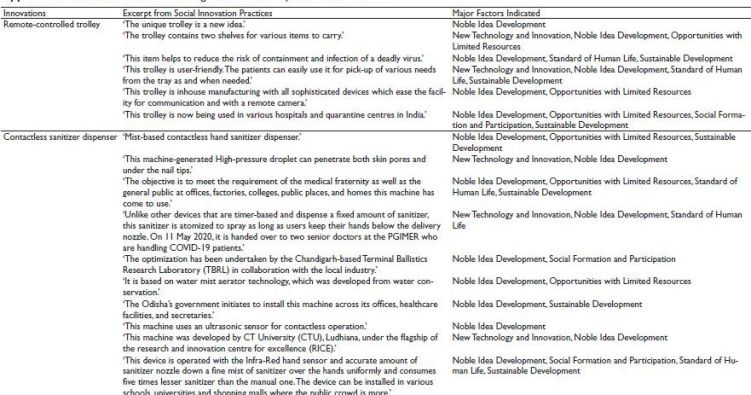
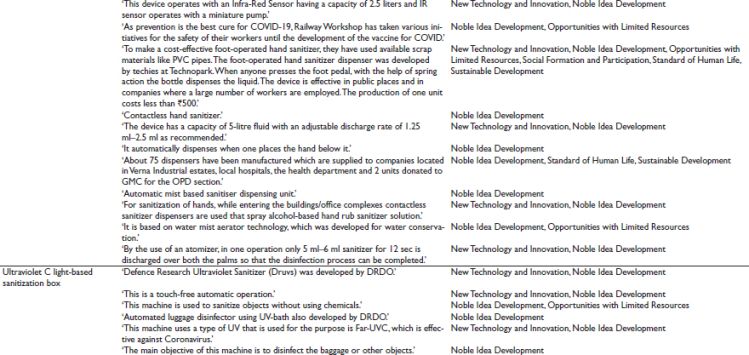

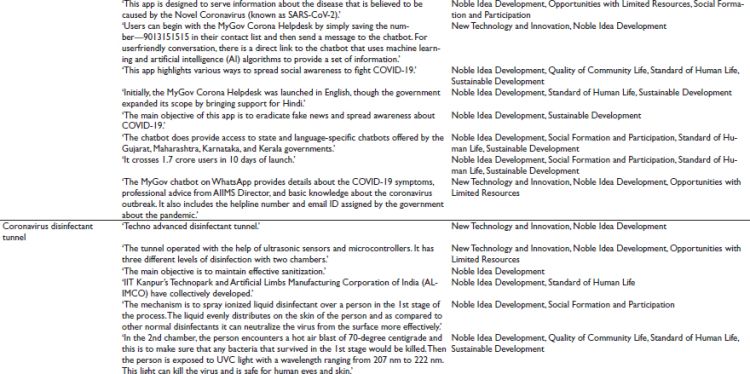
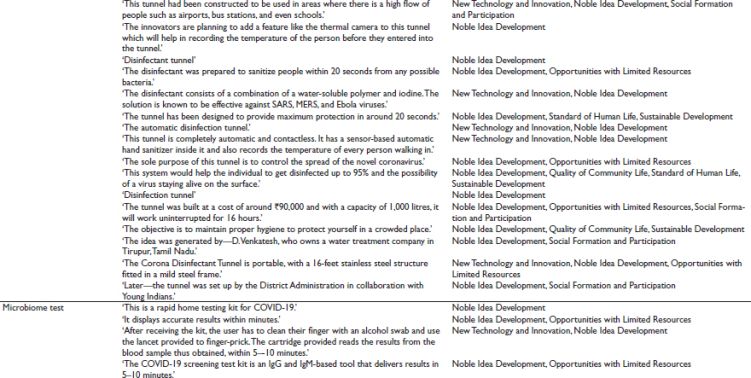
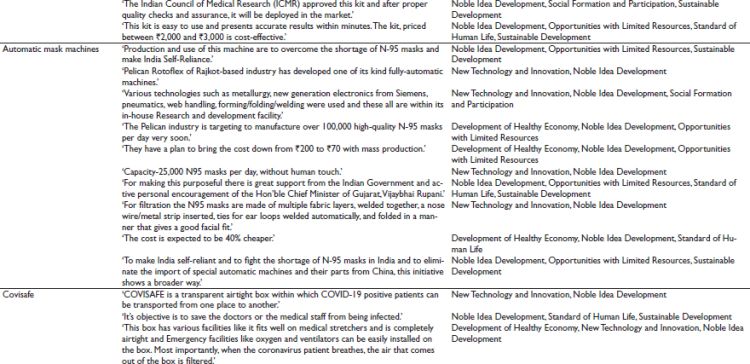
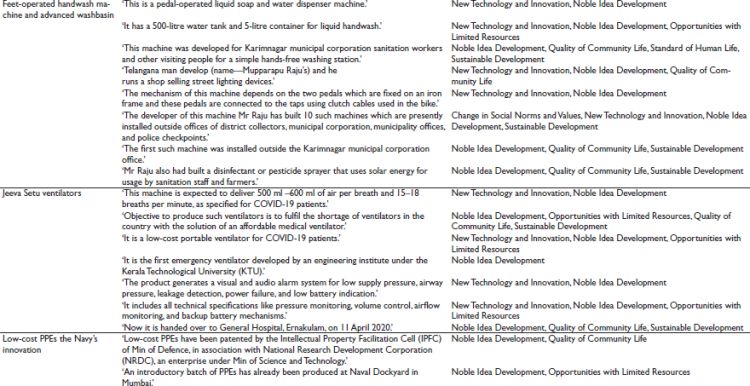
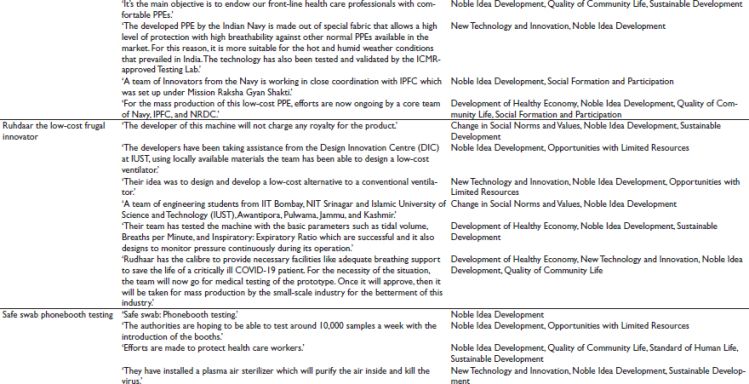
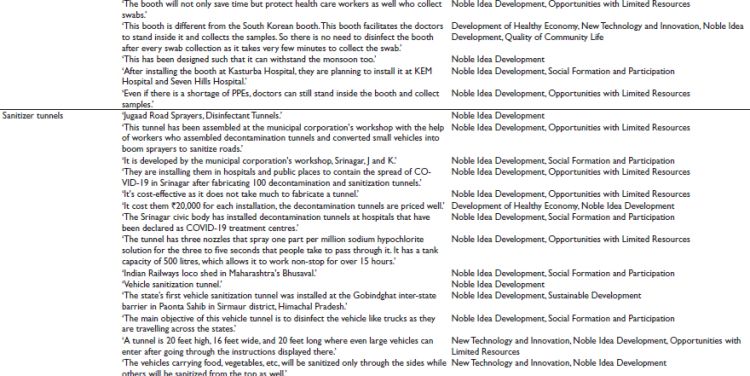
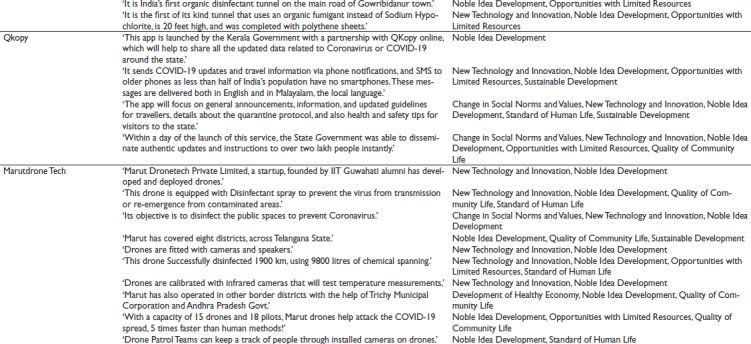
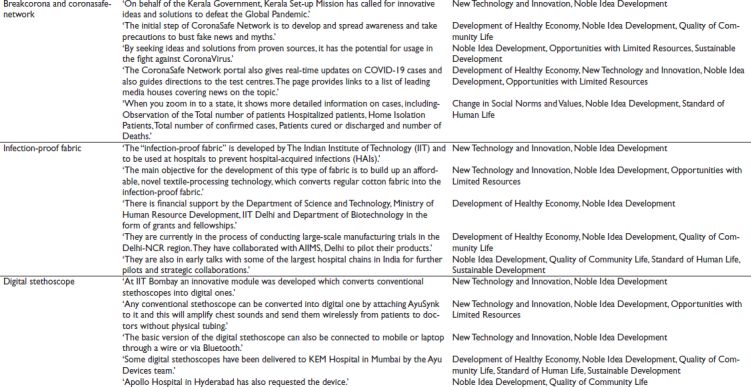
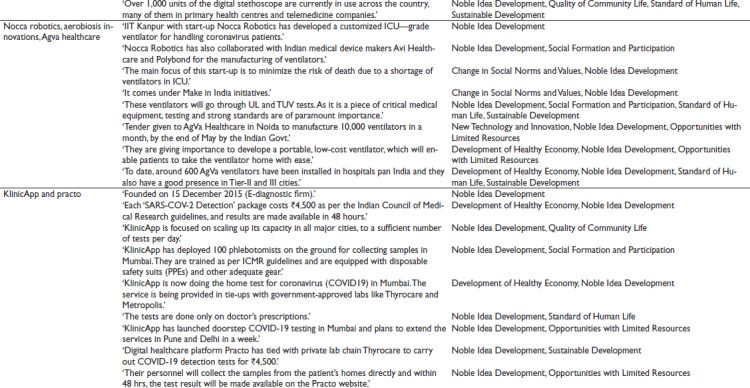
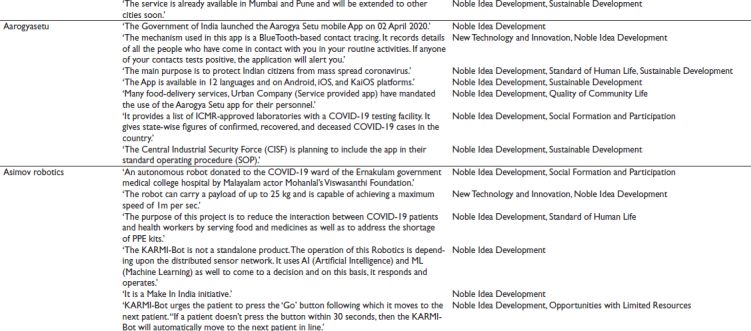

Acknowledgement
The authors would like to express sincere appreciation to Prof. Biswajit Satpathy for providing valuable comments and suggestions to complete this article.
Declaration of Conflicting Interests
The authors declared no potential conflicts of interest with respect to the research, authorship and/or publication of this article.
Funding
The authors received no financial support for the research, authorship and/or publication of this article
Andel, D. V. (2020[A6]). When COVID-19 struck, West Michigan’s generosity and compassion shined. Grand Rapids Business Journal. https://www.crainsgrandrapids.com/opinion/guest-column/when-covid-19-struck-west-michigans-generosity-and-compassion-shined/
Butkeviciene, E. (2009). Social innovations in rural communities: Methodological framework and empirical evidence. Social Sciences, 63, 80–88.
Cerf Vinton, G. (2020). Implications of the COVID-19 pandemic. Association for Computing Machinery.
Express Computer. (2020). Tech innovation assisting countries to combat COVID-19. https://www.expresscomputer.in/industries/healthcare/tech-innovation-assisting-countries-to-combat-covid-19/55113/
Farrugia, G., & Plutowski, R. W. (2020). Innovation lessons from the COVID-19 pandemic. Mayo Clinic Proceedings, 95(8), 1574–1577.
Handforth, C. (2020). Bringing the power of global innovation to tackle COVID-19. United Nation Development Programme (UNDP).
Kilonzo, S. M., & Mugwagwa, J. T. (2009). Societal beliefs, scientific technologies and HIV/AIDS in Africa: Facing the challenge of integrating local communities in Kenya and Zimbabwe. International Journal of Technology Management and Sustainable Development, 8(3), 249–264.
Park, A. (2020). Preventing the next pandemic. TIME Magazine. https://time.com/6202044/preparing-for-next-pandemic-virus-hunters/
Phills, J., Deiglmeier, K., & Miller, D. (2009). Rediscovering social innovation. Stanford Social Innovation Review, Fall, 34–43.
Priestley, J. (2020). Innovation is what you need. TVB Europe, UBM Information Ltd., http://www.tvbeurope.com
Proietti, A. (2020). Today’s innovator. Motivational Press, Inc. https://innov8rs.co/dl.file.php?file=2020/01/Todays-Innovator-Proietti-Innov8rs.pdf
Quinn, G. (2020). Lessons from COVID-19. Inventors Digest (eye on Washington). http://www.inventorsdigest.com
Roome, N. J. (2013). Sustainable development: Social innovation at the interface of business, society and ecology. In T. Osburg & R. Schmidpeter (Eds.), Social innovation. CSR, sustainability, ethics and governance (pp. 299–308). Springer. https://doi.org/10.1007/978-3-642-36540-9_27
Van de Ven, A., Polley, D., & Garud, R., Venkataraman, S. (2008). The innovation journey. Oxford University Press.
WHO Africa. (2020). WHO showcases leading African innovations in COVID-19 response. https://www.afro.who.int/news/who-showcases-leading-african-innovations-covid-19-response
World Economic Forum. (2016). Social innovation. https://www.weforum.org
Websites
Affordable Ventilator. https://www.deccanherald.com/city/top-bengaluru-stories/reva-varsity-unveils-affordable-ventilator-830754.html
Anti-infection Fabric. https://www.business-standard.com/article/current-affairs/covid-19-iit-delhi-makes-anti-infection-fabric-to-curb-hospital-infections-120032700
Artificial Intelligence and Aarogya Sethu. https://www.livemint.com/technology/tech-news/aarogya-setu-app-how-bluetooth-helps-in-identifying-covid-19-suspects-11587730877077.html https://www.livemint.com/ai/artificial-intelligence/how-aarogya-setu-app-works-and-how-it-helps-fight-covid-11594512597402.html
Automatic Machine for Making N95 Masks. https://thepackman.in/pelican-rotoflex-develops-automatic-machine-for-making-n95-masks/
Breakcorona. https://breakcorona.in/
Breathe Ventilator. https://www.investindia.gov.in/siru/helping-india-breathe-ventilator-manufacturing-during-covid-19
Covisafe and Doctors Design for Coronavirus. https://economictimes.indiatimes.com/news/politics-and-nation/maharashtra-doctors-design-covisafe-to-transport-coronavirus-patients/videoshow/74978246.cms?fro
Digital Stethoscope and Remote Auscultation. https://government.economictimes.indiatimes.com/news/digital-india/coronavirus-iit-bombay-develops-digital-stethoscope-for-remote-auscultation/7500374
Disinfection Tunnel for Safety. https://www.outlookindia.com/website/story/india-news-explained-what-are-disinfection-tunnels-and-are-they-safe/350364
Drone Delivering Medicines and Collect Blood Sample. https://www.businessinsider.in/business/startups/news/coronavirus-innovation-this-drone-is-delivering-medicines-collecting-blood-samples-and-spraying-sanitizers-in-telangana/ar
Fight Jugad Road Sprayers. https://www.ndtv.com/srinagar-news/coronavirus-jammu-and-kashmir-in-srinagar-covid-19-fight-jugaad-road-sprayers-disinfectant-tunnels-2207593
Foot Operated Basin. https://timesofindia.indiatimes.com/city/bareilly/northern-railway-employee-builds-foot-operated-basin-to-maintain-social-distancing/articleshow/74998210.cms
Foot Operated Handwash Stations. https://www.tribuneindia.com/news/ludhiana/foot-operated-handwash-stations-installed-at-mandis-74465
Foot Padel Operated Hand Wash. https://www.hindustantimes.com/cities/foot-pedal-operated-hand-wash-machine-installed-at-new-model-running-room/story-tZoXqGFxoGrkX6KdJMkpDN.html
Healthcare and COVID. https://economictimes.indiatimes.com/small-biz/sme-sector/covid-19-ventilators-hospitals-agva-healthcare-coronavirus/articleshow/74840459.cms?from=mdr
Infection Poof Fabric. https://www.deccanherald.com/national/coronavirus-iit-delhi-develops-infection-proof-fabric-to-prevent-hospital-acquired-infections-818155.html
Innovation and Technology. https://www.timesnownews.com/technology-science/article/innovation-and-technology-in-the-age-of-covid/592598
Innovation and Technology. https://www.weforum.org/agenda/2020/05/coronavirus-covid19-innovation-technology-india/
Innovation and Technology in the Age of COVID. https://www.timesnownews.com/technology-science/article/innovation-and-technology-in-the-age-of-covid/592598
Innovation and Technology at the Age of COVID. https://internetkeeda.com/innovation-and-technology-in-the-age-of-covid-19/
Innovation and Technology in COVID-19. https://www.timesnownews.com/technology-science/article/innovation-and-technology-in-the-age-of-covid/592598
Innovation and Technology in the COVID 19 Period. https://www.timesnownews.com/technology-science/article/innovation-and-technology-in-the-age-of-covid/592598
Innovation on Klinicapp. https://yourstory.com/2020/03/coronavirus-diagnostic-startup-klinicapp-covid-19-testing-india
Jeeva Vayu Innovation. https://www.thehindu.com/news/cities/Kochi/jeeva-vayu-to-the-rescue-of-covid-19-patients/article31320430.ece
Kiosk of Foot Operated Hand Wash. https://www.hindustantimes.com/lucknow/dlw-develops-deploys-foot-operated-hand-wash-kiosk/story-iDl1VkQNP6BqSFZOynbcDO.html
Klinicapp Innovation. https://economictimes.indiatimes.com/small-biz/startups/newsbuzz/e-diagnostic-firm-klinicapp-starts-home-tests-for-coronavirus-in-mumbai/articleshow/74882340.cms
Klinicapp Innovation. https://www.inventiva.co.in/trends/surbhi/coronavirus-e-diagnostics-startup-klinicapp-brings-covid-19-testing-to-homes-as-india-scales-up-capacity/
Low Cost Frugal Ventilator. https://kashmirobserver.net/2020/04/23/covid-19-iust-creates-ruhdaar-a-low-cost-frugal-ventilator/
Low Cost Mechanical Ventilator. https://www.ndtv.com/education/team-led-by-iit-bombay-student-develops-low-cost-mechanical-ventilator-ruhdaar-2218662
Man-made Foot-operated Handwash Machines. https://indianexpress.com/article/cities/hyderabad/telangana-man-develops-foot-operated-handwash-machines-to-keep-covid-19-at-bay-6386193/
Marut and COVID 19. https://marutdrones.com/marut-covid19/
Ministry of Health and Family Welfare. https://www.mohfw.gov.in/
Phone Booths for Faster and Safer. https://mumbaimirror.indiatimes.com/coronavirus/news/phone-booths-for-faster-safer-covid-19-testing/articleshow/75018828.cms
Practo Inks Pact Thyrocare. https://www.outlookindia.com/newsscroll/practo-inks-pact-with-thyrocare-to-conduct-covid-tests/1785670
PRID. https://pib.gov.in/PressReleaseIframePage.aspx?PRID=1618375
Public Utility to Fight COVID-19. https://www.geospatialworld.net/blogs/kerala-uses-open-source-public-utility-to-fight-covid-19/
Qkopy for Coronavirus. https://www.news18.com/news/tech/kerala-partners-with-qkopy-for-android-app-to-help-us-track-coronavirus-updates-2537061.html
Smart Stethoscope. https://www.thehindu.com/sci-tech/health/covid-19-iit-b-researchers-smart-stethoscope-can-hear-heart-beats-from-a-distance/article31315366.ece
The Aarogya Sethu App. https://www.thehindu.com/news/national/how-does-the-aarogya-setu-app-work/article31532073.ece
Vehicle Sanitizer Tunnel. https://www.tribuneindia.com/news/himachal/vehicle-sanitisation-tunnel-at-paonta-73370ss